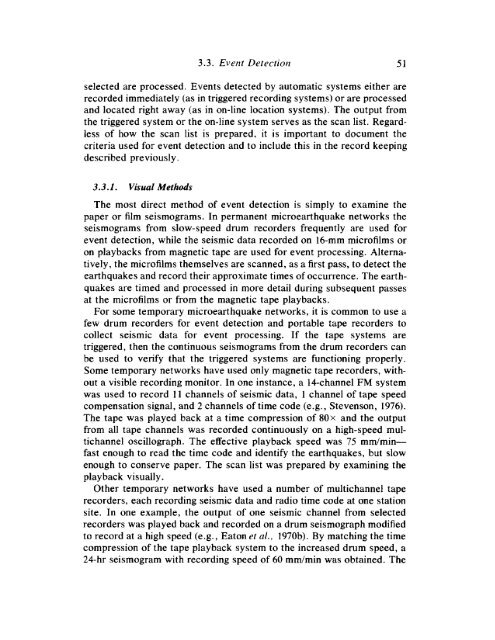principles and applications of microearthquake networks
principles and applications of microearthquake networks
principles and applications of microearthquake networks
Create successful ePaper yourself
Turn your PDF publications into a flip-book with our unique Google optimized e-Paper software.
3.3. Event Deteclion 51<br />
selected are processed. Events detected by automatic systems either are<br />
recorded immediately (as in triggered recording systems) or are processed<br />
<strong>and</strong> located right away (as in on-line location systems). The output from<br />
the triggered system or the on-line system serves as the scan list. Regardless<br />
<strong>of</strong> how the scan list is prepared, it is important to document the<br />
criteria used for event detection <strong>and</strong> to include this in the record keeping<br />
described previously.<br />
3.3.1. Vhal Methods<br />
The most direct method <strong>of</strong> event detection is simply to examine the<br />
paper or film seismograms. In permanent <strong>microearthquake</strong> <strong>networks</strong> the<br />
seismograms from slow-speed drum recorders frequently are used for<br />
event detection, while the seismic data recorded on 16-mm micr<strong>of</strong>ilms or<br />
on playbacks from magnetic tape are used for event processing. Alternatively,<br />
the micr<strong>of</strong>ilms themselves are scanned, as a first pass, to detect the<br />
earthquakes <strong>and</strong> record their approximate times <strong>of</strong> occurrence. The earthquakes<br />
are timed <strong>and</strong> processed in more detail during subsequent passes<br />
at the micr<strong>of</strong>ilms or from the magnetic tape playbacks.<br />
For some temporary <strong>microearthquake</strong> <strong>networks</strong>, it is common to use a<br />
few drum recorders for event detection <strong>and</strong> portable tape recorders to<br />
collect seismic data for event processing. If the tape systems are<br />
triggered, then the continuous seismograms from the drum recorders can<br />
be used to verify that the triggered systems are functioning properly.<br />
Some temporary <strong>networks</strong> have used only magnetic tape recorders, without<br />
a visible recording monitor. In one instance, a 14-channel FM system<br />
was used to record 11 channels <strong>of</strong> seismic data, 1 channel <strong>of</strong> tape speed<br />
compensation signal, <strong>and</strong> 2 channels <strong>of</strong> time code (e.g., Stevenson, 1976).<br />
The tape was played back at a time compression <strong>of</strong> 80x <strong>and</strong> the output<br />
from all tape channels was recorded continuously on a high-speed multichannel<br />
oscillograph. The effective playback speed was 75 mdminfast<br />
enough to read the time code <strong>and</strong> identify the earthquakes, but slow<br />
enough to conserve paper. The scan list was prepared by examining the<br />
playback visually.<br />
Other temporary <strong>networks</strong> have used a number <strong>of</strong> multichannel tape<br />
recorders, each recording seismic data <strong>and</strong> radio time code at one station<br />
site. In one example, the output <strong>of</strong> one seismic channel from selected<br />
recorders was played back <strong>and</strong> recorded on a drum seismograph modified<br />
to record at a high speed (e.g., Eaton et a/., 1970b). By matching the time<br />
compression <strong>of</strong> the tape playback system to the increased drum speed, a<br />
24-hr seismogram with recording speed <strong>of</strong> 60 mdmin was obtained. The






